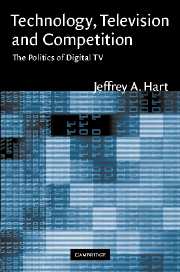Book contents
- Frontmatter
- Contents
- Preface
- Acknowledgments
- List of acronyms
- 1 Introduction
- 2 The institutional setting for advanced TV
- 3 Digital convergence: consumer electronics
- 4 HDTV in Japan
- 5 HDTV in the United States
- 6 HDTV in Europe
- 7 Digital television in the United States
- 8 Digital television in Europe and Japan
- 9 Examples of global standards
- 10 Conclusions
- Index
4 - HDTV in Japan
Published online by Cambridge University Press: 22 September 2009
- Frontmatter
- Contents
- Preface
- Acknowledgments
- List of acronyms
- 1 Introduction
- 2 The institutional setting for advanced TV
- 3 Digital convergence: consumer electronics
- 4 HDTV in Japan
- 5 HDTV in the United States
- 6 HDTV in Europe
- 7 Digital television in the United States
- 8 Digital television in Europe and Japan
- 9 Examples of global standards
- 10 Conclusions
- Index
Summary
The global story of HDTV begins with the decision of Japan's national public broadcaster, NHK (Nippon Hoso Kyokai), to begin research on next-generation television technologies. Prior to and during the 1964 Tokyo Olympics, there was a major jump in TV sales in Japan. The dissatisfaction of engineers at NHK's Technical Laboratories with the quality of television coverage of the Tokyo Olympics and the improved ability of NHK to finance television research were the two main reasons why NHK Laboratories began to do research on advanced television technologies in 1964. From that point on, NHK was the key actor pushing for HDTV in Japan. NHK's leadership depended critically on its control over the core technologies for Japan's version of HDTV. Because NHK was enjoined by law not to engage directly in manufacturing activities, it began in 1970 to assemble a coalition of manufacturers to support its work on HDTV technologies. NHK then used its coalition to win support for national HDTV standards. It did not succeed in winning sufficient support for its approach to HDTV outside of Japan, however, for reasons to be explored in later chapters.
NHK's research on MUSE/Hi-Vision
Two NHK laboratories were established in 1930: one for broadcasting issues (including viewer surveys) and the other for technical issues. NHK Science and Technical Research Laboratories (NHK Labs for short) were supposed to investigate scientific and technical issues with the potential to have long-term effects on broadcasting.
- Type
- Chapter
- Information
- Technology, Television, and CompetitionThe Politics of Digital TV, pp. 84 - 99Publisher: Cambridge University PressPrint publication year: 2004



